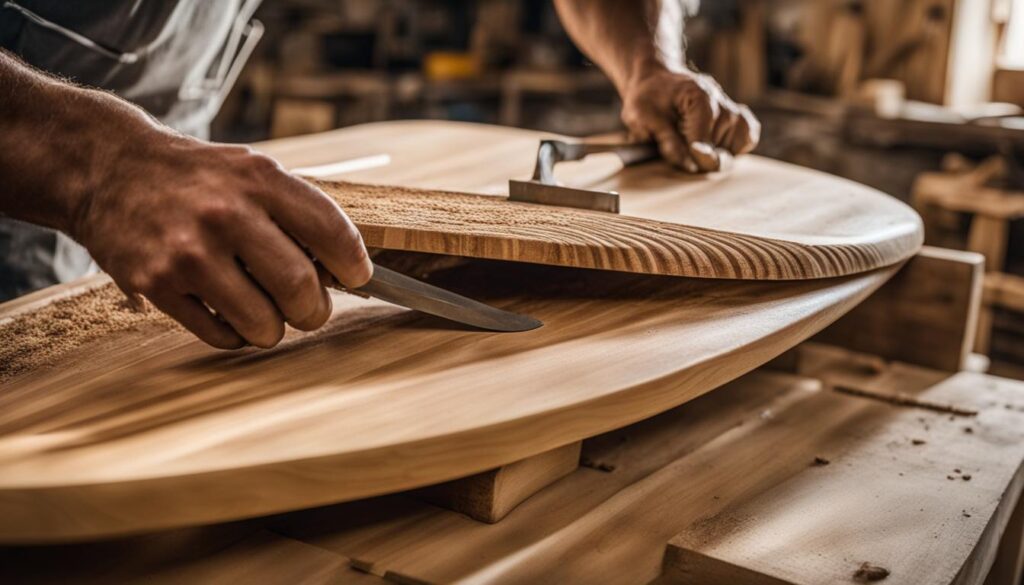When you think of surfboards, what materials come to mind? Foam, fiberglass, and resin are likely at the top of the list. But what about wood? Are surfboards made of wood? In recent years, wooden surfboards have been making a comeback, attracting surfers who are looking for a more eco-friendly alternative. In this article, we will explore the materials used in surfboard construction, including the growing popularity of wooden surfboards and their unique characteristics.
Wood surfboard construction offers a sustainable option for surfers who are conscious of their environmental impact. But what makes wooden surfboards stand out? How do they compare to traditional foam and fiberglass boards in terms of performance? And what does the future hold for wooden surfboards? Join us as we dive deeper into the world of wooden surfboard craftsmanship and discover the advantages, challenges, and potential of this eco-friendly alternative.
The Resurgence of Wooden Surfboards
Over the years, the materials used to make surfboards have evolved, leading to the dominance of foam and fiberglass construction. However, there has been a resurgence of interest in wooden surfboards due to their eco-friendly nature and unique performance characteristics.
Wooden surfboards offer a more sustainable option compared to traditional foam and fiberglass boards, which are made from non-recyclable petrochemicals. Wood is a renewable resource and can be sourced locally, reducing the carbon footprint associated with transportation.
Wooden surfboards also offer a different riding experience, with their heavier weight providing increased momentum and glide. While they may not be suitable for professional surfing due to their weight, wooden surfboards are highly durable and can last for decades with proper care.
The choice between wood and fiberglass surfboards ultimately depends on the surfer’s preference for performance, sustainability, and connection to the natural materials used in wooden board construction.
A Brief History of Surfboard Materials
The history of surfboard materials is a fascinating journey that dates back to ancient Polynesia. Centuries ago, the Polynesians were the first to ride waves on wooden boards, showcasing their incredible skill and connection with the ocean. These wooden surfboards played a significant role in the Polynesian culture and were crafted with care and precision.
However, it wasn’t until the mid-20th century that the surfboard industry experienced a revolutionary change with the introduction of foam and fiberglass. Foam cores, particularly polyurethane foam, replaced wood as the primary material for surfboards.’
The combination of foam cores and fiberglass cloth wrapped in resin resulted in surfboards that were lighter, more maneuverable, and highly durable. This groundbreaking development transformed the surfing experience and set the industry standard for many years to come.
Since then, foam has continued to evolve, offering surfers different options and performance characteristics. Expanded polystyrene (EPS) and extruded polystyrene (XPS) foam have also been utilized in surfboard construction, further enhancing the versatility and performance of modern boards.
Despite these advancements, there has been a resurgence in the popularity of wooden surfboards. Surfers and enthusiasts alike have recognized the unique benefits of wooden boards that harken back to the early days of surfing.
Wooden surfboards are not just a nod to tradition; they also offer sustainability and a one-of-a-kind riding experience. The wooden surfboard movement is driven by a desire to connect with nature, reduce environmental impact, and appreciate the craftsmanship and artistry that goes into creating each board.
The juxtaposition of ancient wooden surfboards and the foam and fiberglass revolution showcases the rich history and evolution of surfboard materials. It is a testament to the innovation and creativity within the surfing community, and the continuous quest to find the perfect ride.
Pros and Cons of Wooden Surfboards
Wooden surfboards have become a popular alternative to traditional foam and fiberglass boards, offering unique advantages and disadvantages for surfers. Understanding the pros and cons of wooden surfboards can help you make an informed decision about which type of board is right for you.
Pros of Wooden Surfboards
- Increased Momentum and Glide: The heavier weight of wooden surfboards provides enhanced momentum and glide, making them ideal for twin fins, mid length single fins, and longboards. Surfers can enjoy a smooth and graceful ride with improved speed and momentum.
- Durability: Wooden surfboards are highly durable and can last for many years with proper care and maintenance. They have the ability to withstand general wear and tear, and any dings or damages can be easily repaired, minimizing the need for replacement.
- Eco-Friendly Construction: Choosing a wooden surfboard contributes to reducing your environmental impact. Wood is a renewable resource that can be sustainably harvested from local forests. By opting for a wooden board, you support regenerative forestry practices and minimize the use of non-recyclable petrochemical materials used in foam and fiberglass boards.
Cons of Wooden Surfboards
- Heavier Weight: Wooden surfboards are typically heavier compared to foam and fiberglass boards. While this weight provides enhanced momentum, it may affect maneuverability, especially for surfers who prefer more agile and responsive boards.
- Water Absorption: Wood has the potential to absorb water, which can make the board heavier over time. This may affect the performance and buoyancy of the board, particularly in challenging surf conditions.
Despite these limitations, wooden surfboards offer a sustainable and unique riding experience that appeals to many environmentally conscious surfers. The choice between wooden surfboards and foam and fiberglass boards depends on your individual preferences for performance, durability, and environmental impact.
Sustainable Surfboard Materials and Construction Techniques
Sustainable surfboard materials and construction techniques play a crucial role in reducing the environmental impact of surfboard production and promoting the use of renewable resources. With a focus on eco-friendliness, surfboard manufacturers are adopting innovative practices that prioritize sustainability. These practices involve the use of locally sourced wood and the implementation of construction techniques that minimize waste and maximize durability.
One of the key sustainable surfboard materials used in wooden surfboard construction is locally sourced wood, such as Western Red Cedar and Poplar. These types of wood can be sustainably harvested from regenerative woodlands, ensuring the minimal impact on the environment. By using wood from well-managed forests, surfboard manufacturers actively contribute to the sustainability and regrowth of these natural resources.
Not only does the use of locally sourced wood reduce the carbon footprint associated with transportation, but it also supports regional economies and promotes the preservation of local ecosystems. This emphasis on locally sourced wood aligns with the principles of sustainability and reduces the reliance on materials that require extensive transportation and production processes.
Eco-friendly construction techniques further enhance the sustainability of wooden surfboards. One such technique is skin-on-frame construction, which involves wrapping a wooden frame with a durable skin material, such as fiberglass or bio-based alternatives. This method allows for the efficient use of wood, minimizing waste, and ultimately reducing the environmental impact of surfboard production.
Harnessing these sustainable construction techniques contributes to the longevity of wooden surfboards. With proper care, wooden boards can last for decades, reducing the need for frequent replacements and minimizing waste. This durability not only supports the principle of sustainability but also offers surfers a long-term investment in a high-quality surfboard.
To illustrate the sustainable surfboard materials and construction techniques, here is a table showcasing a comparison between conventional surfboard materials and the eco-friendly alternatives:
| Surfboard Material | Conventional | Eco-Friendly Alternative |
|---|---|---|
| Foam Core | Polyurethane foam (non-recyclable) | Plant-based foam or recycled foam |
| Resin | Polyester resin (petroleum-based) | Epoxy resin (bio-based or recycled) |
| Fiberglass | Conventional fiberglass | Flax or hemp fiberglass alternatives |
This comparison highlights the shift towards more sustainable alternatives in surfboard construction, emphasizing materials that have a reduced environmental impact. The use of plant-based foam, bio-based resins, and sustainable fiberglass alternatives contributes to the overall eco-friendliness of surfboards, while maintaining performance and durability.
Choosing Sustainability for a Better Surfing Future
By utilizing sustainable surfboard materials and construction techniques, surfers can make a positive impact on the environment and support the preservation of our oceans and coastlines. The adoption of locally sourced wood, along with eco-friendly construction practices, ensures that surfers can enjoy their favorite sport while minimizing their ecological footprint.
It is important for surfers, manufacturers, and the industry as a whole to embrace sustainability and actively seek out ways to reduce environmental impact. Making conscious choices in surfboard materials and construction techniques contributes to a more sustainable surfing future, where waves can be enjoyed for generations to come.
Performance and Riding Experience of Wooden Surfboards
Wooden surfboards offer a unique performance and riding experience compared to foam and fiberglass boards. The heavier weight of wooden boards provides increased momentum and glide, allowing surfers to find smooth and graceful lines.
This characteristic makes wooden surfboards well-suited for twin fins, mid length single fins, and longboards, where momentum is key. Surfers have reported that wooden boards allow for smoother and more graceful turns, and they can generate speed without as much effort.
While wooden surfboards may not be as maneuverable as foam and fiberglass boards, they excel in generating speed and providing a stable ride. The combination of performance and durability makes wooden surfboards a popular choice for surfers seeking a unique and eco-friendly riding experience.

The Benefits of Wooden Surfboards
“Wooden boards have a distinct feel on the wave. They have this amazing ability to generate speed and maintain momentum, allowing for flow and style in every ride.” – Emma Wilson, professional surfer
Wooden surfboards offer several advantages that enhance the riding experience:
- Increased momentum and glide
- Smooth and graceful turns
- Effortless speed generation
- Stability in varied wave conditions
Surfers appreciate the unique performance characteristics of wooden surfboards, which allow them to enjoy a thrilling and satisfying ride. The weight and construction of wooden boards contribute to a sense of connection with the wave, creating an immersive and enjoyable surfing experience.
Wooden Surfboards and Sustainability
Wooden surfboards offer a more sustainable option compared to foam and fiberglass boards. By using locally sourced, sustainably harvested wood, surfers can minimize their environmental impact and support regenerative forestry practices. Wooden surfboards are also highly durable, with the potential to last for decades with proper care and maintenance. This longevity reduces the need for frequent replacements, ultimately reducing waste.
Additionally, wooden surfboards can be repaired easily, further extending their lifespan. Choosing a wooden surfboard is a conscious decision to reduce environmental impact and contribute to the sustainability of the surfing industry. While no surfboard is entirely sustainable, wooden surfboards offer a more environmentally friendly alternative that aligns with the values of eco-conscious surfers.
The Future of Wooden Surfboards
The increasing popularity of wooden surfboards signals an exciting future for sustainable surfing. With environmental consciousness on the rise, surfers are gravitating towards the eco-friendly and unique riding experience that wooden boards offer. This growing interest has prompted many surfboard manufacturers to incorporate sustainable materials and construction techniques into their designs, further fueling the popularity of wooden surfboards.
One aspect driving the future of wooden surfboards is the rise of custom boards. Surfers now have the opportunity to have a board tailored specifically to their individual needs and preferences. Custom surfboards provide a personalized touch, enabling surfers to fine-tune their equipment for optimal performance in the water.
In addition to custom boards, make-your-own workshops have become increasingly popular among surfers. These workshops offer enthusiasts the chance to create their very own wooden surfboard under the guidance of experienced craftsmen. It provides a hands-on experience, allowing participants to connect with the boardmaking process and develop a deeper appreciation for the craftsmanship involved.
As surfers prioritize sustainability and seek out the unique characteristics of wooden boards, the future of wooden surfboards looks bright. Surfers can enjoy the thrill of riding waves while minimizing their environmental impact and supporting regenerative forestry practices.
With an increasing number of surfers embracing wooden surfboards, the demand for sustainable and custom-made options is likely to continue growing. The future holds the promise of innovative designs, sustainable materials, and the preservation of traditional craftsmanship, all contributing to the enduring appeal of wooden surfboards.
Conclusion
In conclusion, wooden surfboards are an excellent choice for surfers who are environmentally conscious and value a unique riding experience. By using locally sourced, sustainably harvested wood and eco-friendly construction techniques, wooden surfboards minimize environmental impact and promote the longevity of resources. These boards offer increased momentum and glide, making them well-suited for certain surfing styles and conditions.
While wooden surfboards may not be as maneuverable as foam and fiberglass boards, they make up for it with their durability and potential for lasting decades with proper care. Surfers can enjoy the peace of mind that comes with choosing a surfboard made from sustainable materials.
The popularity of wooden surfboards continues to rise, and surfers now have the option of custom boards and make-your-own workshops, providing a deeper connection to their surfboards and a sense of pride in contributing to sustainability. Wooden surfboards are not only a conscious choice for surfers who prioritize performance, but also for those who want to make a positive impact on the environment. By choosing wooden surfboards, surfers can ride the waves with style and sustainability, knowing they are leaving a smaller ecological footprint.


thank you for this informative blogpost! really enjoyed reading it.
Thanks for letting me know!